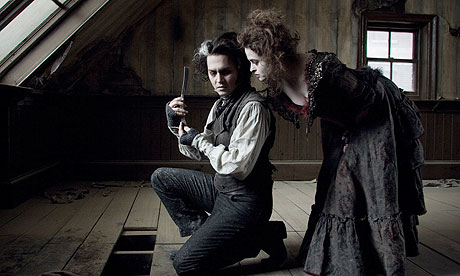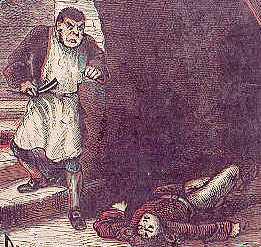
I think it’s safe to say that we have all at least heard of Tim Burton’s take on “Sweeney Todd” in his 2007 musical film Sweeney Todd: Demon Barber of Fleet Street. The story features Johnny Depp as Mr. Todd, a barber who was exiled to Australia under false pretenses, who returns to London to seek revenge on those who wronged him with the help of Mrs. Lovett (played by Helena Bonham Carter). The film features some mild blood and gore (nothing we aren’t use to nowadays), a few meat pies, as well as a story of young love.
So before we begin to look at the musical aspect, here’s a little background on our beloved Demon Barber.
Sweeney Todd was a name coined in the “Penny Dreadfuls” in the early 19th century, but became popular with author Edward Lloyd’s (1815-1890) The People’s Periodicals and Family Library, published between 1846 and 1847. Lloyd created an elaborate background to the character and said he was a real man, overshadowed by Jack the Ripper in their time. However, there is no evidence to prove that Todd truly existed.
The character was created in a time when going to a barber shop was an everyday experience. In the days before electric shavers, men with a few coins in their pocket would hit up a local barber to give them a nice, “close shave.” It was an intimate, vulnerable few minutes for barber and patron, so when the story of a demon barber was published, naturally it became all the rage in the horror genre. 
Since then, the legend of Sweeney Todd was picked up and revised into the Broadway musical Sweeney Todd: The Demon Barber of Fleet Street by composer Stephen Sondheim in 1979. Tim Burton received permission from the composer to create the film in 2006, and the film was released late the next year.
Now, let’s take a quick look at the story portrayed by Burton.
Todd, fresh back from his exile and looking for revenge, has his mind set to murder only 2 people: the judge and his rat-like assistant, who exiled Todd on fraudulent charges so the judge could get his hands on Todd’s young and beautiful wife, Lucy. After his failure on both these counts, he becomes obsessed with the killing, much to the benefit of Mrs. Lovett. **SPOILERS** He does eventually achieve his goal of killing both men, but also his wife–whom he believed to be dead–nearly his own daughter, Mrs. Lovett, and in the end, himself.
Now, with a bit of history on the film, we can look at some of the choices made with the material. For instance, why would you make a story featuring a blood-thirsty/serial killing barber into a musical? Upon explaining the plot to my roommate, she found it gruesome and intriguing. But when I said “musical,” confusion ensued.
Music and murder don’t really seem to go hand-in-hand, but look at it like this. What is music? Passion. Pure, unadulterated passion. And the same can probably be said for murder, especially in the case of revenge, such as it is with Mr. Todd. Sweeney Todd is, after all, a tragic, bloodstained love story.
Mixing music in with probably the worst crime a human can commit (second to rape, which is also suggested in this film through the song “Poor Thing”) is meant to represent the positive and negative aspects of human moral and soul. Good and evil, justice and corruption, as well as love and hate are all very present themes throughout this film, and the best way to explore the minds and views of a character is for them to blatantly sing it out into the world. Though macabre movies are usually quite slow, with only dialogue and subtle tricks in cinema to give an idea of what the characters think, Sweeney Todd has no problem explaining it. The songs each give a new piece to the story, the background, and a character’s inner thoughts.
The opening song, “No Place Like London,” is an excellent example to effective story telling through music. It features Todd and young Anthony looking at the city with very different views. Anthony is young and hopeful, seeing London as a place to call home and full of opportunities to find success. He begins the song lightly, to be joined by his travelling companion Todd, who turns the song into a far more brutish ballad, cursing London as a dirty, “shit-smelling” city full of liars. This contrast in its own provides a brilliant moment of characterization between Todd and Anthony and proves why using music in film can be so moving. In a single song we get a certain level of exposition and learn, on the surface, Todd’s motivation throughout the film. It lures in the audience with the promise of a very dark turn to the film (for those who weren’t drawn in by the blood-soaked intro credits).
Truthfully, the screenplay was made for Broadway. It was meant to be theatrical. There is rarely success with musical films, but I believe Sweeney Todd to be an excellent example of one that succeeded stylistically. Each song has meaning, and music itself brings the audience in to experience the passionate moments along with the characters, with every breath a moral struggle and every held note a decision.
Furthermore, the musical aspect of the film was one of the hurdles Burton had to overcome in order to get rights to the film. The director and the composer went back and forth with casting to find a pair fit for the screen version of the popular Broadway production. If the actors could not sing the parts, they would not get the parts. Burton fought for Depp and Carter to be cast, and eventually Sondheim relented. Though Sweeney Todd did not do so well when it first came out, it later became a fan favorite due to is macabre nature and alternative-style story telling.
Though many musical films are forgotten over time, Sweeney Todd’s history and brilliant portrayal in the film world and on the stage have earned it an almost cult-classic reputation.

Sources:
Barsam, Richard Meran., and Dave Monahan. Looking at movies: an introduction to film. New York: W.W. Norton & Co., 2010. Print.
The Guardian. Guardian News and Media, n.d. Web. 18 Jan. 2017.
Jones, Richard. “THE REAL SWEENEY TODD.” Sweeney Todd – The Demon Barber of Fleet Street. N.p., n.d. Web. 18 Jan. 2017.
Powers, Review By Gabriel. “Sweeney Todd: The Demon Barber of Fleet Street: Special Edition.” DVD News, DVD Reviews & More at DVDActive. WiredTree, 02 Apr. 2008. Web. 18 Jan. 2017.
Sweeney Todd, the demon barber of Fleet Street. Dir. Tim Burton. Prod. Richard D. Zanuck, Walter F. Parkes, Laurie MacDonald, and John Logan. By John Logan and Stephen Sondheim. Perf. Johnny Depp, Helena Bonham Carter, Alan Rickman, and Timothy Spall. N.p., n.d. Web.
“Sweeney Todd: The Demon Barber of Fleet Street.” IMDb. IMDb.com, n.d. Web. 18 Jan. 2017.
“Sweeney Todd: The Demon Barber of Fleet Street.” Wikipedia. Wikimedia Foundation, n.d. Web. 18 Jan. 2017.
“The History of Sweeney Todd: The Demon Barber of Fleet Street.” Time Out London. N.p., n.d. Web. 18 Jan. 2017.